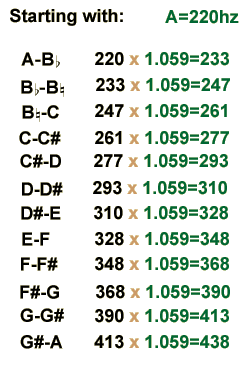The Tempered Scale
During the Baroque period (1600-1750) composers began to push for a better balanced musical scale. They were getting bored with being forced to write entire pieces in one tonal center, and a new system of musical intervals was developed to solve this problem.
The new system divided each of the 12 notes into equal intervals, compromising the perfection of each individual interval for the overall adequecy of all pitches. The solution was an extremely mathematical one. Knowing that an octave would double a pitch, and that there are 12 notes in an octave, theorists determined that the difference between each semitone would be the 12 root of 2, which is approximately 1.059. Isn't that simple? Well, no, so here's an example of how it works:

The numbers don't quite add up in this example due to rounding errors, but this is how the system works exactly when exact numbers are used. This is the tuning system which made works like Bach's Well Tempered Klavier and all modern music possible. This is also the tuning system which other music and crop circles theorists have not given much attention too.
